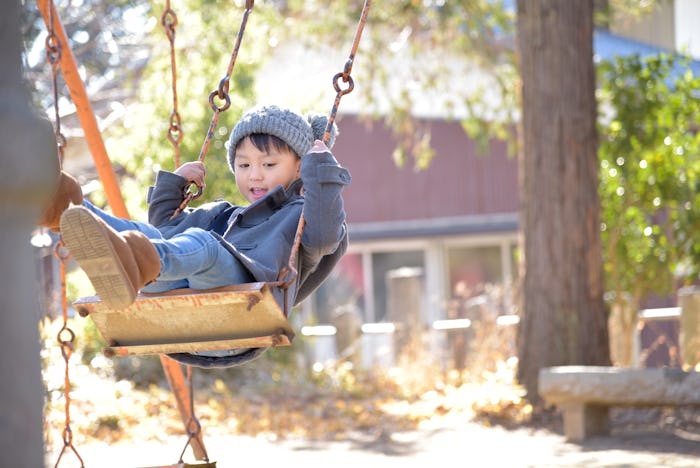Life

Here Are 5 Things Doctors Really Want Parents To Know About Swings
Swings are a staple of childhood. Nothing can beat the excitement of soaring through the air with nothing but a narrow 4-inch seat under your tush and two chains to cling to for dear life. While swings can be a ton of fun on the playground, they can also be pretty dangerous, too. That’s why there are things your doctor wants you to know about swings to keep your kiddo safe.
Who hasn’t tried to do a mid-air twist while leaping off of a swing? (No self-respecting swinger I know.) After all, it’s almost uncool to wait for the swing to come to a full stop and then slide off of it cautiously. No, in most cases, jumping off of the swing while it’s almost parallel to the crossbar is the way to work it. But it’s exactly that scenario that gets kids sent to the emergency room with broken bones, concussions, and worse. The Centers for Disease Control and Prevention (CDC) reported that over 200,000 children ages 14 and younger go to the emergency room for playground-related accidents every year. And as for home playgrounds, swings incur the most injuries.
So how can you keep your little swinger safe without sabotaging his good time? Pediatrician Dr. Cherilyn Cecchini offers the following insights into swing safety.
1Know When To Use The Swing
If you’re toting your tot to the playground, you can take your baby out of the stroller and put her into the swing when she’s about 6 months old. “Your child may begin using an outdoor swing at that age if he or she is able to sit upright and maintain control of his or her head,” says Dr. Cecchini. Waiting until she can sit up will prevent her head from wobbling around in the seat — and you’ll avoid potential head or neck injury.
2Learn Which Swing To Use
When you get to the playground, you might find a slew of swings to choose from. But for a baby, a bucket seat swing will do just fine. “A bucket seat is designed for babies and toddlers since they have holes for legs and support the back and torso,” says Dr. Cecchini. Around two years of age, most children can transition to a high back baby seat, which provides back support, but allows for more leg freedom. These seats usually have a seat beat and vinyl bar, which helps them feel secure. And around 4 years-old, most children can begin using a regular swing seat.
3Know How To Swing Correctly
Sure, it can be fun to soar through the air like a superhero, but keep your caped crusader safe by teaching her how to swing correctly. (Which, as you guessed, is on her butt.) “Discourage kids from swinging on tummies or from jumping off,” advises Dr. Cecchini. Yes, you might get the stink eye from your kid, but keeping her safe is part of your parental duty.
4Avoid Attachments
While pumping her legs and trying to fly higher and higher should be enough to entertain your child, never try to add anything onto the swing that shouldn’t already be there to enhance the experience. “Never attach ropes, clotheslines, or leashes to the equipment,” advises Dr. Cecchini. “And look out for and remove tripping hazards, such as rocks or tree stumps or branches.” That way, your child can stick her landing... without sticking herself on something sharp on the ground.
5Always, Always Supervise
When you think about it, a swing is a seat solely secured by two ropes. Any number of safety issues can (and do) happen. That’s why adult guidance and supervision is the best way to prevent injuries. Says Dr. Cecchini: “Always be sure to watch closely and be ready to step in and intervene if they aren't using the equipment appropriately.”
You want your child to have a blast while she’s swinging at the playground, but you also want to keep her safe, too. Supervise her swinging and she should stay out of harm’s way.
Expert:
Dr. Cherilyn Cecchini, a pediatrician with Your Doctors Online
This article was originally published on